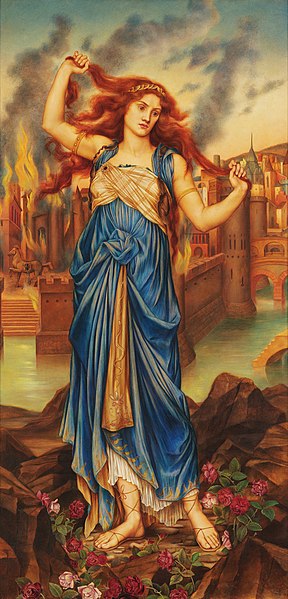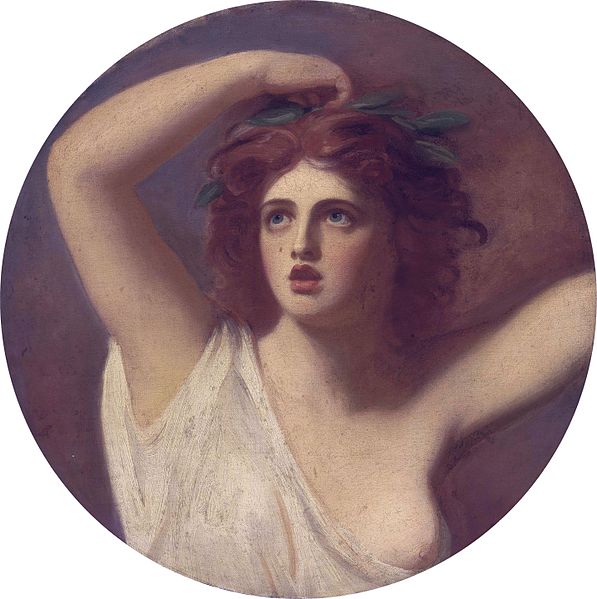In the vast tapestry of Greek mythology, few figures are as tragic and intriguing as Cassandra. This Trojan princess, blessed with the gift of prophecy yet cursed to never be believed, stands as a poignant symbol of the perils of ignored wisdom.
Cassandra Key Facts
| Parents | King Priam and Queen Hecuba of Troy |
| Partners | Taken as prize of war by Agamemnon |
| Siblings | Hector, Paris, and many others |
| Offspring | None |
| Other names | Cassandre |
| Roman name | Cassandra |
| Best Known Myth | Her prophecies during the Trojan War |
Name and Etymology
Cassandra (Greek Kassandra), is a name rooted in the ancient Greek language. The name itself can be broken down into two parts: “kassu,” which means “to excel or to shine,” and “aner,” which translates to “man.” Thus, her name can be interpreted as “she who excels over men.” In Roman mythology, she retains her Greek name, a testament to her enduring legacy across cultures. Throughout various texts, she’s also been graced with epithets that highlight her tragic gift, such as “the doomed prophetess.”

Cassandra’s Family and Relationships
Born to the royal lineage of Troy, Cassandra was the daughter of King Priam and Queen Hecuba. Her family was vast and influential, with each member playing a significant role in the tapestry of the Trojan War and Greek mythology.
Her most renowned sibling was Hector, the valiant hero and champion of Troy, whose bravery and tragic end at the hands of Achilles, The Mightiest Champion is a story often recounted. But Hector was just one among many. Paris, another brother, was the very catalyst for the Trojan War, having abducted the beautiful Helen, The Enchanting Beauty from her husband Menelaus, the king of Sparta. Then there was Deiphobus, who, after the death of Paris, married Helen and met a tragic end during the fall of Troy. Helenus, another brother, was, like Cassandra, blessed with the gift of prophecy. Troilus, a younger brother, was a prince of outstanding beauty and valor who met a tragic end at the hands of Achilles. Polyxena, her sister, was sacrificed at the tomb of Achilles, while another sister, Creusa, was married to Aeneas, The Trojan Hero Who Founded Rome, a union that would lead to the legendary lineage of the founders of Rome.
Growing up amidst such illustrious siblings, Cassandra’s life was intertwined with tales of valor, love, and tragedy from the very beginning. Her birth was marked by omens; it was said that upon her birth, a soothsayer predicted her tragic fate as a prophetess who would never be believed. As she grew, her gift of prophecy began to manifest, setting her apart even in such a distinguished family.
Among her relationships, the most notable was with Agamemnon, the Greek king who took her as a concubine after the fall of Troy. Their relationship was tumultuous and ultimately tragic, ending in both their deaths.
Myths about Cassandra
Greek mythology is rife with tales of heroism, love, and tragedy, and Cassandra’s story is no exception. Her life, intertwined with prophecies and curses, offers a deep well of tales that have been recounted for generations.
The Gift and Curse of Cassandra
Cassandra, the daughter of King Priam and Queen Hecuba of Troy, held a unique place in the annals of Greek mythology. With an elder brother like Hector, the celebrated hero of the Greek-Trojan war, she was no stranger to the weight of destiny.
The origins of her prophetic abilities are steeped in intrigue and divine intervention. The most ancient tales, as recounted by playwrights like Aeschylus, tell of the sun god Apollo, who was deeply smitten by Cassandra’s beauty. To win her affections, he granted her the divine gift of foresight. However, in a twist of fate and passion, after she received this gift, Cassandra reneged on her promise of love to Apollo. Enraged, yet unable to take back a divine gift, Apollo cursed her: she would retain her ability to foresee the future, but no soul would believe her prophecies.
However, other sources, including writings by Hyginus and Pseudo-Apollodorus, offer a slightly different narrative. In these versions, Cassandra never made a promise to Apollo. Instead, the gift of prophecy was an enticement, a divine lure to kindle a romantic relationship. When this divine overture failed to ignite the desired passion, Apollo, in his frustration, added the curse to her gift.
Yet, in later renditions of her tale, the origins of her gift take on a more mystical tone. It is said that Cassandra once fell into a deep slumber within a sacred temple. As she slept, serpents whispered secrets into her ears or licked them, granting her the uncanny ability to hear and see future events.
The Desecration at Athena’s Temple
As the walls of Troy crumbled and the city met its tragic fate, Cassandra, in her desperation, sought refuge in the temple of Athena. Embracing the wooden statue of the goddess, she pleaded for protection. However, her sanctuary was violated by Ajax the Lesser, who brutally raped her within the sacred confines of the temple. The act was not just a violation of Cassandra but also a grave sacrilege. As she clung to the statue, seeking solace, Ajax’s forceful actions knocked it from its stand.
The desecration of the temple and the violation of a supplicant under Athena’s protection invoked the wrath of the gods. As recounted by Apollodorus, Ajax met a grim fate. Athena, in her fury, struck his ship with a thunderbolt. Though he initially survived, boasting of his safety, Poseidon split the rock he clung to, causing Ajax to fall into the sea and meet his doom. His body, later washed ashore, was buried by Thetis in Myconos.
The Fall of Troy
The Trojan War, a conflict that raged for a decade, saw Cassandra in one of its most pivotal moments. As the Greeks seemingly retreated, they left behind a massive wooden horse as an offering to Athena. However, Cassandra foresaw the danger lurking within this “gift.”
She passionately warned her fellow Trojans about the Greek soldiers hidden inside the Trojan Horse, pleading with them to see the ruse for what it was. But Apollo’s curse held firm. Her frantic warnings were dismissed as mere ramblings. That night, as the city of Troy reveled in their supposed victory, the Greek soldiers emerged from the horse, setting in motion the city’s tragic downfall.
The Tragedy with Agamemnon
The fall of Troy was just the beginning of Cassandra’s woes. Captured and taken as a prize of war, she found herself in the clutches of Agamemnon, the Greek king. Despite her captive status, her prophetic abilities remained intact. She foresaw the grim fate that awaited both her and Agamemnon upon their return to Mycenae.
Clytemnestra, Agamemnon’s wife, driven by revenge for the sacrifice of their daughter Iphigenia, plotted their deaths. As with all her prophecies, this too was met with disbelief. She knew that her life, intertwined with prophecies and the curse of Apollo, was destined for a tragic end. Despite her attempts to change her fate, the threads of destiny proved too strong to alter. Cassandra’s pleas and warnings to Agamemnon went unheeded. Finally, in a tragic twist of fate, both met their end at Clytemnestra’s hands.

Depiction And Characteristics
Cassandra often appears as a young, beautiful woman, her distressed expression reflecting her tragic fate. Moreover, she frequently holds a laurel branch, showcasing her link to Apollo. Her eyes, often wide and filled with foreboding, reflect the weight of her visions.
In myths, her personality is one of despair and frustration. Blessed to foresee calamities, however powerless to prevent them. She embodied the tragic irony of knowing the future but being unable to change it. Ravens, often seen as symbols of omens, are frequently associated with her, thereby highlighting her prophetic skills even more.
Representations Of Cassandra In Art
Throughout history, Cassandra’s tragic tale has inspired countless artists. In classical art, she’s often portrayed at the moment of her deepest despair, especially during the fall of Troy. One of the most renowned depictions is on the “Ajax and Cassandra” amphora. On it she’s shown seeking refuge at Athena’s altar.
In more modern times, her story has been retold in both operas and plays. Serving as a poignant reminder of the perils of unheeded wisdom. Her image, always haunting, serves as a powerful symbol of tragic foresight.
Mentions in Ancient Texts
Cassandra’s haunting tale has left an indelible mark on ancient literature. Various authors, each with their unique style, have touched upon her story, offering glimpses into her tragic life.
Homer’s “Iliad”
Written around the 8th century BC, the “Iliad” by Homer, the legendary blind poet of ancient Greece, is an epic that primarily focuses on the Trojan War. While Cassandra’s role is somewhat limited, her presence is palpable, especially in the context of the war’s later stages. Quote: “Yet golden-throned Hera, looking down, pitied her, and at once incited the Achaean women to wail aloud, so that white-armed Andromache might hear, as she came from the palace, that her husband still lived, but that he was held by the Achaean spearmen, who were dragging him towards their hollow ships.”
Aeschylus’s “Agamemnon”
Aeschylus, a playwright from the 5th century BC, is often referred to as the father of tragedy. Moreover, in his play “Agamemnon,” he delves deep into Cassandra’s relationship with the Greek king. The narrative captures her despair as she foresees their impending deaths. Specifically, the quote: “Alas, the agony! Again it throbs—my brain! The foreknowledge of my own death,” highlights her anguish.
Euripides’s “The Trojan Women”
Euripides, another great tragedian of classical Athens, wrote “The Trojan Women” in 415 BC. This play offers a harrowing look at the aftermath of the Trojan War, focusing on the fates of the captured Trojan women, including Cassandra. Quote: “O Sun-god, in my maiden chamber’s recesses I have often, often sung thee, but now in different strains: Ah me! I hymn my last, my bridal song, sung for the dead.”
Virgil’s “Aeneid”
Virgil, the ancient Roman poet, penned the “Aeneid” in the 1st century BC. This epic poem, which tells the story of the Trojan hero Aeneas, briefly touches upon Cassandra’s tragic fate during the fall of Troy. Quote: “Chaste Cassandra was dragged, with disheveled hair, from the temple and shrine of Minerva, lifting her burning eyes to heaven in vain: her eyes, for cords bound her soft hands.”
Frequently Asked Questions
Cassandra was blessed with the gift of prophecy by Apollo. However, when she rejected his advances, he cursed her so that no one would believe her predictions.
She was the daughter of King Priam and Queen Hecuba of Troy.
Yes, she warned the Trojans about the Greeks inside the Trojan Horse, but her warnings were ignored.
Agamemnon took her as a concubine, a relationship that ended tragically for both.
She’s often shown with a laurel branch, symbolizing her connection to Apollo.
Featured Image Credit: Codrus Painter, Public domain, via Wikimedia Commons
